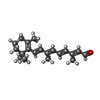[English] 日本語
 Yorodumi
Yorodumi- PDB-1fbk: CRYSTAL STRUCTURE OF CYTOPLASMICALLY OPEN CONFORMATION OF BACTERI... -
+ Open data
Open data
- Basic information
Basic information
| Entry | Database: PDB / ID: 1fbk | ||||||
|---|---|---|---|---|---|---|---|
| Title | CRYSTAL STRUCTURE OF CYTOPLASMICALLY OPEN CONFORMATION OF BACTERIORHODOPSIN | ||||||
 Components Components | BACTERIORHODOPSIN | ||||||
 Keywords Keywords |  PROTON TRANSPORT / PROTON TRANSPORT /  PROTON PUMP / PROTON PUMP /  MEMBRANE PROTEIN / MEMBRANE PROTEIN /  RETINAL PROTEIN / TWO-DIMENSIONAL CRYSTAL ELECTRON DIFFRACTION / RETINAL PROTEIN / TWO-DIMENSIONAL CRYSTAL ELECTRON DIFFRACTION /  SINGLE CRYSTAL SINGLE CRYSTAL | ||||||
| Function / homology |  Function and homology information Function and homology information photoreceptor activity / photoreceptor activity /  phototransduction / proton transmembrane transport / monoatomic ion channel activity / phototransduction / proton transmembrane transport / monoatomic ion channel activity /  plasma membrane plasma membraneSimilarity search - Function | ||||||
| Biological species |   Halobacterium salinarum (Halophile) Halobacterium salinarum (Halophile) | ||||||
| Method |  ELECTRON CRYSTALLOGRAPHY / ELECTRON CRYSTALLOGRAPHY /  electron crystallography / electron crystallography /  cryo EM / Resolution: 3.2 Å cryo EM / Resolution: 3.2 Å | ||||||
 Authors Authors | Subramaniam, S. / Henderson, R. | ||||||
 Citation Citation |  Journal: Nature / Year: 2000 Journal: Nature / Year: 2000Title: Molecular mechanism of vectorial proton translocation by bacteriorhodopsin. Authors: S Subramaniam / R Henderson /  Abstract: Bacteriorhodopsin, a membrane protein with a relative molecular mass of 27,000, is a light driven pump which transports protons across the cell membrane of the halophilic organism Halobacterium ...Bacteriorhodopsin, a membrane protein with a relative molecular mass of 27,000, is a light driven pump which transports protons across the cell membrane of the halophilic organism Halobacterium salinarum. The chromophore retinal is covalently attached to the protein via a protonated Schiff base. Upon illumination, retinal is isomerized. The Schiff base then releases a proton to the extracellular medium, and is subsequently reprotonated from the cytoplasm. An atomic model for bacteriorhodopsin was first determined by Henderson et al, and has been confirmed and extended by work in a number of laboratories in the last few years. Here we present an atomic model for structural changes involved in the vectorial, light-driven transport of protons by bacteriorhodopsin. A 'switch' mechanism ensures the vectorial nature of pumping. First, retinal unbends, triggered by loss of the Schiff base proton, and second, a protein conformational change occurs. This conformational change, which we have determined by electron crystallography at atomic (3.2 A in-plane and 3.6 A vertical) resolution, is largely localized to helices F and G, and provides an 'opening' of the protein to protons on the cytoplasmic side of the membrane. | ||||||
| History |
|
- Structure visualization
Structure visualization
| Movie |
 Movie viewer Movie viewer |
|---|---|
| Structure viewer | Molecule:  Molmil Molmil Jmol/JSmol Jmol/JSmol |
- Downloads & links
Downloads & links
- Download
Download
| PDBx/mmCIF format |  1fbk.cif.gz 1fbk.cif.gz | 54.6 KB | Display |  PDBx/mmCIF format PDBx/mmCIF format |
|---|---|---|---|---|
| PDB format |  pdb1fbk.ent.gz pdb1fbk.ent.gz | 41.3 KB | Display |  PDB format PDB format |
| PDBx/mmJSON format |  1fbk.json.gz 1fbk.json.gz | Tree view |  PDBx/mmJSON format PDBx/mmJSON format | |
| Others |  Other downloads Other downloads |
-Validation report
| Arichive directory |  https://data.pdbj.org/pub/pdb/validation_reports/fb/1fbk https://data.pdbj.org/pub/pdb/validation_reports/fb/1fbk ftp://data.pdbj.org/pub/pdb/validation_reports/fb/1fbk ftp://data.pdbj.org/pub/pdb/validation_reports/fb/1fbk | HTTPS FTP |
|---|
-Related structure data
- Links
Links
- Assembly
Assembly
| Deposited unit | 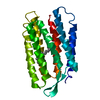
| ||||||||
|---|---|---|---|---|---|---|---|---|---|
| 1 | 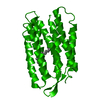
| ||||||||
| Unit cell |
| ||||||||
| Details | Trimer is present in vivo. The crystals contain trimers related by crystal symmetry P3. |
- Components
Components
| #1: Protein |  Mass: 26678.330 Da / Num. of mol.: 1 / Mutation: D96G,F171C,F219L / Source method: isolated from a natural source / Source: (natural)   Halobacterium salinarum (Halophile) / References: UniProt: P02945 Halobacterium salinarum (Halophile) / References: UniProt: P02945 |
|---|---|
| #2: Chemical | ChemComp-RET /  Retinal Retinal |
-Experimental details
-Experiment
| Experiment | Method:  ELECTRON CRYSTALLOGRAPHY / Number of used crystals: 402 ELECTRON CRYSTALLOGRAPHY / Number of used crystals: 402 |
|---|---|
| EM experiment | Aggregation state: 2D ARRAY / 3D reconstruction method:  electron crystallography electron crystallography |
| Crystal symmetry | ∠γ: 120 ° / A: 62.45 Å / B: 62.45 Å / C: 100.9 Å / Space group name H-M: P3 |
- Sample preparation
Sample preparation
| Component | Name: CYTOPLASMICALLY OPEN CONFORMATION OF BACTERIORHODOPSIN Source: RECOMBINANT | ||||||||||||||||||||||||||||||
|---|---|---|---|---|---|---|---|---|---|---|---|---|---|---|---|---|---|---|---|---|---|---|---|---|---|---|---|---|---|---|---|
| Molecular weight | Value: .027 MDa / Experimental value: NO | ||||||||||||||||||||||||||||||
| Source (natural) | Organism:   Halobacterium salinarum (Halophile) Halobacterium salinarum (Halophile) | ||||||||||||||||||||||||||||||
| Specimen | Embedding applied: YES / Shadowing applied: NO / Staining applied : NO / Vitrification applied : NO / Vitrification applied : YES : YES | ||||||||||||||||||||||||||||||
| EM embedding | Material: glucose or trehalose | ||||||||||||||||||||||||||||||
Crystal grow | Temperature: 310 K / Method: naturally occurring in vivo / pH: 7 Details: crystals are increased in size by fusion and annealing using detergents, pH 7, naturally occurring in vivo, temperature 37K | ||||||||||||||||||||||||||||||
| Crystal grow | *PLUS Temperature: 4 ℃ / pH: 5.6 / Method: unknown | ||||||||||||||||||||||||||||||
| Components of the solutions | *PLUS
|
-Data collection
| Microscopy | Model: FEI/PHILIPS CM12 / Details: imaging date 1998-12-01 |
|---|---|
| Electron gun | Illumination mode: FLOOD BEAM |
| Electron lens | Mode: DIFFRACTION |
| Image recording | Film or detector model: GENERIC CCD / Num. of diffraction images: 1000 |
| Diffraction | Mean temperature: 93 K |
| Diffraction source | Source: ELECTRON MICROSCOPE / Type: OTHER / Wavelength: 0.033 |
| Detector | Type: OTHER / Detector: CCD / Date: Dec 1, 1998 |
| Radiation | Protocol: SINGLE WAVELENGTH / Monochromatic (M) / Laue (L): M / Scattering type: electron |
| Radiation wavelength | Wavelength : 0.033 Å / Relative weight: 1 : 0.033 Å / Relative weight: 1 |
| Reflection | Resolution: 3.2→200 Å / Num. all: 7298 / Num. obs: 5668 / % possible obs: 77.7 % / Observed criterion σ(I): 0 / Rmerge(I) obs: 0.173 |
- Processing
Processing
| Software | Name: CNS / Version: 0.9 / Classification: refinement | |||||||||||||||||||||||||
|---|---|---|---|---|---|---|---|---|---|---|---|---|---|---|---|---|---|---|---|---|---|---|---|---|---|---|
| Crystal symmetry | ∠γ: 120 ° / A: 62.45 Å / B: 62.45 Å / C: 100.9 Å / Space group name H-M: P3 | |||||||||||||||||||||||||
3D reconstruction | Resolution: 3.2 Å / Resolution method: DIFFRACTION PATTERN/LAYERLINES Details: 402 patterns merged (merging R 17.3%) to generate set of lattice lines covering ~87% of reciprocal space, with resolution of 3.2 A in-plane and 3.6 A vertically [primary citation] | |||||||||||||||||||||||||
| Refinement | Resolution: 3.2→200 Å / Stereochemistry target values: Engh & Huber Details: Each diffraction pattern was automatically indexed, and the spot intensities were integrated either using a raster (for patterns recorded at specimen tilts less than 30 degrees) or using ...Details: Each diffraction pattern was automatically indexed, and the spot intensities were integrated either using a raster (for patterns recorded at specimen tilts less than 30 degrees) or using profile fitting (for patterns recorded at specimen tilts at or greater than 30 degrees, which represented about 80% of the total data set). Each pattern was then compared to the curves recorded for wild-type bacteriorhodopsin in glucose at -100 degrees C [Ceska and Henderson J. Mol. Biol. 213: 539-560 (1990)], and the relative proportions of the four different twins determined. This exercise was carried out with all four theoretically possible orientations of the crystal axes relative to the previous reference curves to ensure that the data were merged correctly. From the initial set of 486 patterns chosen, 286 minimally twinned diffraction patterns were selected in which the major twin proportion was greater than 0.8. These 286 patterns were merged using the wild-type lattice lines as a reference and lattice lines were fitted to the data to obtain an initial approximately merged set of lattice lines (merge #1) describing the structure of the triple mutant. The original set of 486 patterns was then merged against the new lattice curves to redetermine the twin proportions more accurately. The merging parameters for each crystal were inspected carefully again, and 84 crystals for which the major twin proportion was less than 0.70 were excluded from the data set. The remaining 402 substantially untwinned diffraction patterns were used to generate a new set of curves and the procedure repeated to create a stable set of lattice lines. The merged data were further improved by using an estimate of sigma values for each reflection, and by the inclusion of an individual weighting factor for each diffraction pattern using procedures described by Grigorieff and Henderson [Ultramicroscopy 60: 295-309 (1995)]. Two cycles of this refinement were carried out to obtain a final set of merged curves. The curves were sampled at 1/100 Angstroms (approximately twice the thickness of the membrane) to obtain a set of intensities at H,K,L values so that the data could be further processed with standard X-ray crystallographic programs. For the tilt angles used, the maximal possible theoretical completeness of the data set is ~87%. The completeness of our data is close to this limit up to 3.5 Angstroms. The completeness drops to 77.7 % when all of the data to 3.2 Angstroms is included.
| |||||||||||||||||||||||||
| Refinement step | Cycle: LAST / Resolution: 3.2→200 Å
| |||||||||||||||||||||||||
| Refine LS restraints |
|
 Movie
Movie Controller
Controller



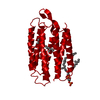
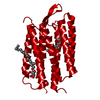
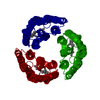
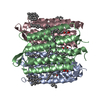
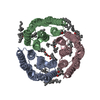
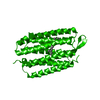
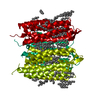
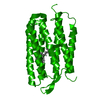
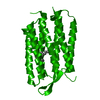
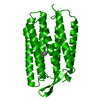
 PDBj
PDBj





